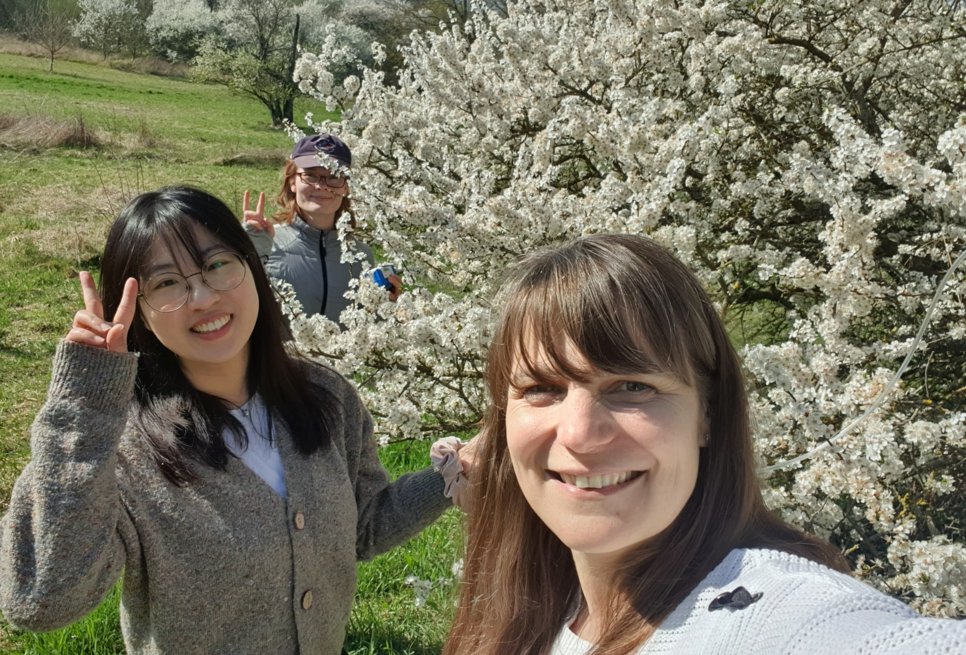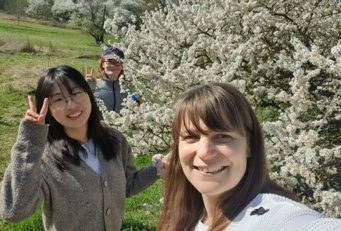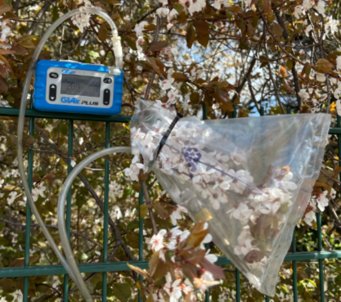Blackthorn (Prunus Spinosa)
A Glimpse into Its Chemical Scent Signature

Blackthorn is a native wild plant with high ecological value. Its flowers appear early in the year and serve as an important nectar source for a wide variety of insects.
Pictured Eunyeong Jin (PhD candidate), Nicola Sörmann (bachelor student), and Alexandra Gutmann (postdoctoral researcher) preparing for scent sampling at a blooming blackthorn. (Photo by Alexandra Gutmann)
Blackthorn is one of the first shrubs to bloom in spring. Even before its leaves appear, it shows its small, white flowers – and releases an intense fragrance: sweet, almond-like, with a slightly bitter note. It is a native wild plant with high ecological value. Its flowers appear early in the year and serve as an important nectar source for a wide variety of insects. On warm days, the scent is especially noticeable.

Floral volatiles are collected on site using sorptive materials and later analyzed in the laboratory via thermal desorption gas chromatography–mass spectrometry (TD-GC-MS). This enables precise identification of the complex chemical composition. (Photo and sampling by Eunyeong Jin)
This distinctive fragrance makes Blackthorn an ideal subject for our project. We analyze its floral scent emissions using advanced analytical techniques – directly in the field. Floral volatiles are collected on site using sorptive materials and later analyzed in the laboratory via thermal desorption gas chromatography–mass spectrometry (TD-GC-MS). Combining subjective perception with chemical analysis provides new insights into the role of scents in plant ecosystems.
Emission Spectrum of Blackthorn
As part of our investigation into floral scent communication, we analyzed the emission spectrum of blackthorn (Prunus spinosa). The chromatogram below shows the composition of volatile organic compounds (VOCs) emitted by the flowers. These compounds play a crucial role in how the plant interacts with its environment—particularly in attracting pollinators.

The chromatogram illustrates the volatile organic compounds (VOCs) emitted by blackthorn blossoms. Each peak represents a distinct substance—among them ecologically relevant scent molecules such as ocimene, lilac aldehyde, and phellandrene. (Measurement and analysis by Eunyeong Jin)
We identified a wide array of compounds. Some of them play particularly prominent roles in the scent profile and ecological function of blackthorn:
🌿 Phellandrene
Phellandrene is a monoterpene with a fresh, spicy aroma, often associated with eucalyptus or citrus. Found in various plant species, it can act both as an attractant and a repellent for insects. Its presence in blackthorn suggests a versatile role in olfactory communication.
🍏 cis-3-Hexenyl acetate
This compound belongs to the group of so-called "green leaf volatiles" and is typically released upon mechanical damage to plant tissue. Its fruity, apple-like scent can attract pollinators—but also alert predators of herbivores. It is a fascinating example of multifunctional chemical signaling in nature.
🌸 Lilac Aldehyde
Lilac aldehyde is a major component in the scent of many flowers—including lilac. It exists in several isomeric forms, each with slightly different odors. In our measurements, lilac aldehyde emerges as a potentially attractive signal for nocturnal pollinators such as hawkmoths.
🍯 4-Oxoisophorone
This substance is a degradation product of carotenoids and contributes a sweet, fruity note to the overall fragrance. Previous studies have identified it in plants with specialized pollinator relationships—a possible indication of a targeted scent strategy in blackthorn as well.
🌼 Ocimene
Ocimene is a common floral volatile occurring in multiple stereoisomeric forms. It is known to strongly influence the behavior of bees and other insects. Due to its high volatility, it functions effectively as a short-range attractant.
🔬 The chromatogram provides a glimpse into the diversity and dynamics of the scent compounds released by flowers. Such scent profiles not only deepen our understanding of the ecological role of plants but also shed light on the evolution of chemical communication between flora and fauna.
Text: Alexandra Gutmann


